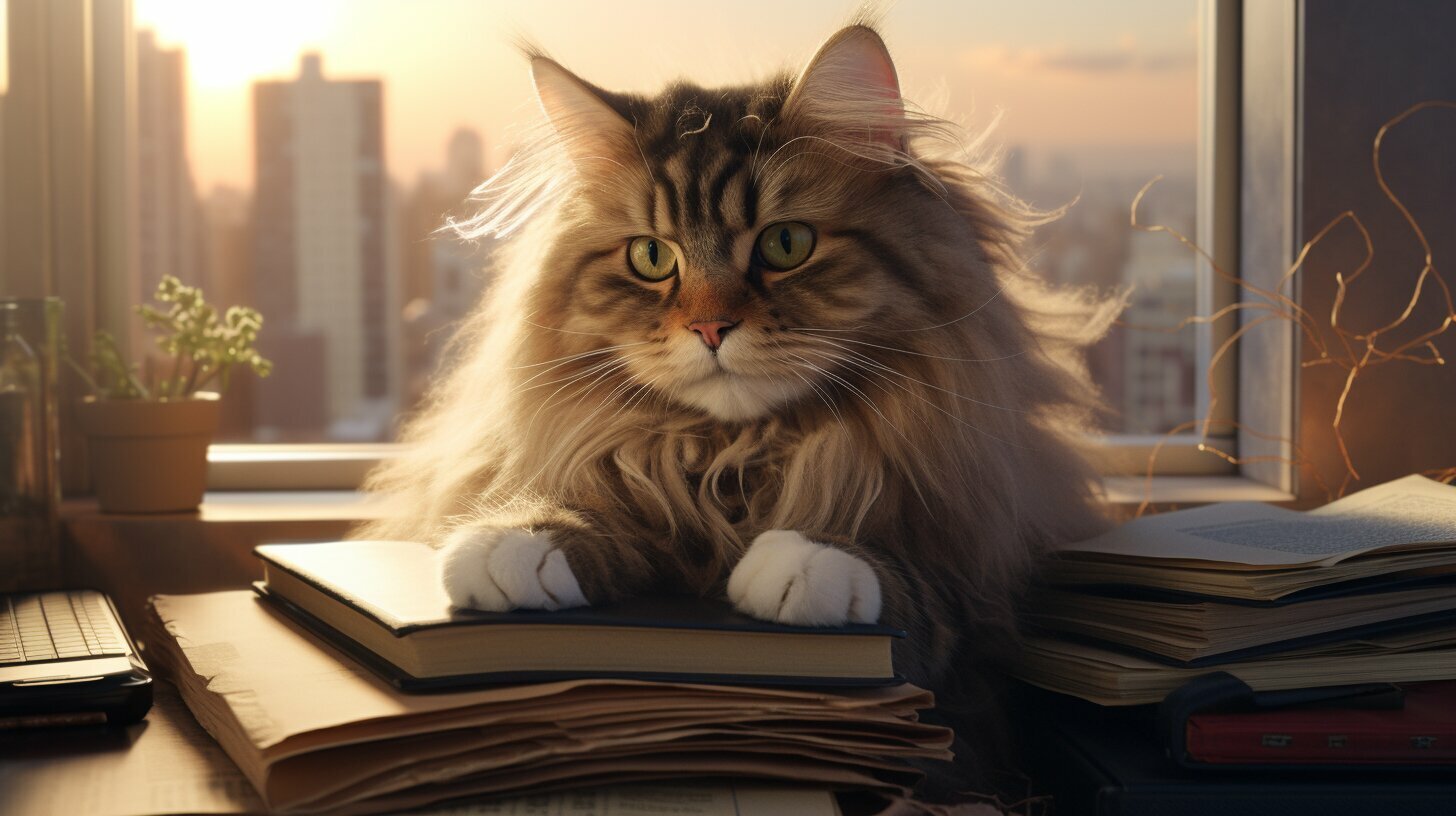Unraveling the Mystery: Why Do Cats Eat Hair?
Do you often find yourself wondering why cats have a peculiar habit of eating their own hair? Cats engage in the behavior of eating their fur for several reasons, and understanding this behavior is important for their overall well-being. Excessive grooming and fur consumption can lead to health concerns such as hairballs and skin irritation. It can also be indicative of underlying emotional distress or medical conditions. In this article, we will delve into the reasons behind why cats eat their hair and explore ways to manage this behavior.
Factual data: Cats have an instinctual drive to groom, spending a significant amount of time cleaning themselves. However, when grooming becomes excessive, it can lead to hair ingestion and hairball formation. Stress and anxiety can contribute to excessive grooming, and cats may use it as a coping mechanism. Medical conditions such as allergies, skin irritations, and gastrointestinal issues can also cause cats to eat their fur. Seeking professional help from a veterinarian or animal behaviorist is recommended when excessive grooming and fur consumption become severe or harmful. Managing excessive grooming includes creating an engaging environment for cats, introducing new experiences, using pheromone products, and consulting with a vet.
Key Takeaways:
- Cats eat their own hair for several reasons, including instinctual grooming behavior.
- Excessive grooming and fur consumption can lead to health concerns such as hairballs and skin irritation.
- Stress, anxiety, and underlying medical conditions can contribute to excessive hair ingestion.
- Seeking professional help from a veterinarian or animal behaviorist is recommended for severe or harmful cases.
- Managing excessive grooming includes creating an engaging environment, introducing new experiences, and using pheromone products.
The Curious Case of Hairball Formation
Cats have a natural inclination to groom themselves, but have you ever wondered why this grooming behavior sometimes goes awry, leading to the formation of hairballs? Excessive grooming and fur consumption can result in health concerns for our feline friends, including hairballs and skin irritation. Understanding the reasons behind this behavior is crucial for their overall well-being.
When cats groom themselves, they use their tongues to lick their fur, which helps to remove dirt and keep their coat clean. However, if grooming becomes excessive, cats can end up swallowing a significant amount of their own fur. This accumulated fur can form hairballs in their digestive system, causing discomfort and potential blockages. Hairballs can lead to symptoms such as vomiting, loss of appetite, and even constipation.
But what causes cats to engage in excessive grooming and fur consumption? Stress and anxiety can play a significant role. Just like humans, cats may resort to certain behaviors, such as excessive grooming, as a way to cope with emotional distress. Additionally, certain medical conditions can cause cats to eat their fur, including allergies, skin irritations, and gastrointestinal issues. It’s important to consult with a veterinarian or animal behaviorist to identify and address any underlying issues that may be contributing to this behavior.
So, how can we prevent hairball formation and manage excessive grooming in cats? Creating an engaging environment for our feline companions can help reduce stress and anxiety. Introducing new experiences and toys can provide mental stimulation and distract them from excessive grooming. Additionally, pheromone products, such as sprays or diffusers, can help create a calming atmosphere in their environment. And of course, consulting with a veterinarian or animal behaviorist is essential for professional guidance specific to your cat’s needs.
Unraveling the Emotional and Medical Triggers
Excessive hair ingestion in cats can be attributed to a range of emotional and medical triggers, shedding light on the underlying reasons behind this peculiar behavior. Cats, by nature, are meticulous groomers, spending a large portion of their day cleaning themselves. However, when grooming becomes excessive, it can lead to the ingestion of hair and the formation of hairballs. Understanding the emotional and medical triggers behind this behavior is crucial in managing and addressing it effectively.
Stress and anxiety can play a significant role in excessive grooming and hair consumption in cats. Just like humans, cats can experience emotional distress, and excessive grooming can become a coping mechanism. It is important to create an environment that minimizes stressors and provides ample opportunities for mental and physical stimulation. Introducing new toys, engaging in interactive play, and providing scratching posts can help divert their attention away from excessive grooming.
Medical conditions can also contribute to excessive hair ingestion in cats. Allergies, skin irritations, and gastrointestinal issues can prompt cats to consume their fur as a response to discomfort. Identifying and treating these underlying medical issues is vital in managing the behavior. Consulting with a veterinarian or animal behaviorist is recommended to rule out any underlying medical conditions and develop a comprehensive treatment plan.
| Managing Excessive Hair Ingestion in Cats |
|---|
| Creating an engaging environment for cats |
| Introducing new experiences and toys |
| Using pheromone products to reduce stress and anxiety |
| Consulting with a veterinarian or animal behaviorist |
Managing excessive hair ingestion in cats involves a holistic approach that addresses both the emotional and medical triggers. By creating a stimulating environment and providing appropriate outlets for their natural behaviors, cats can be encouraged to redirect their excessive grooming tendencies. Additionally, consulting with a veterinarian or animal behaviorist can help identify and address any underlying medical issues contributing to the behavior. With the right support and management strategies, cats can lead happier and healthier lives, free from the negative consequences of excessive hair ingestion.
Managing Excessive Hair Ingestion in Cats
If your furry friend is prone to excessive grooming and hair consumption, don’t worry! There are effective ways to manage this behavior and promote your cat’s overall well-being.
One strategy is to create an engaging environment that provides your cat with plenty of mental and physical stimulation. This can include introducing new toys, puzzles, and interactive playtime to distract them from excessive grooming. Experiment with different types of toys to find what captures their interest and keeps them occupied.
| Tip | Description |
|---|---|
| Rotate Toys | Keep your cat engaged by rotating their toys regularly. This helps prevent boredom and encourages them to focus on playtime rather than grooming. |
| Provide Scratching Posts | Scratching is a natural behavior for cats and can act as a stress reliever. By providing scratching posts and surfaces, you can redirect their energy and reduce excessive grooming. |
| Use Treat Dispensing Toys | Treat dispensing toys can be a great way to keep your cat mentally stimulated and provide a positive distraction from grooming. They encourage problem-solving and reward your cat for engaging with the toy. |
Another helpful approach is to use pheromone products, such as sprays or diffusers, which can help reduce stress and anxiety in your cat. These products mimic the natural pheromones that cats release when they feel safe and secure. By creating a comforting environment, you can help alleviate any emotional triggers that may be causing excessive grooming.
“Using pheromone products can be a game-changer when it comes to managing excessive grooming in cats. They have a calming effect and can help reduce stress, which can be a major factor in this behavior.”
It’s also important to consult with a veterinarian or animal behaviorist to rule out any underlying medical conditions that may be contributing to your cat’s excessive grooming. Allergies, skin irritations, and gastrointestinal issues can all lead to increased hair ingestion. If medical issues are identified, appropriate treatment can be provided to address the root cause of the behavior.
Conclusion
By unraveling the mystery of why cats eat hair, we can improve the lives of our feline companions and ensure their well-being for years to come. Cats engage in the behavior of eating their own fur for several reasons. Excessive grooming and fur consumption can lead to health concerns such as hairballs and skin irritation. It can also be indicative of underlying emotional distress or medical conditions.
Cats have an instinctual drive to groom, spending a significant amount of time cleaning themselves. However, when grooming becomes excessive, it can lead to hair ingestion and hairball formation. Stress and anxiety can contribute to excessive grooming, and cats may use it as a coping mechanism. Medical conditions such as allergies, skin irritations, and gastrointestinal issues can also cause cats to eat their fur.
Seeking professional help from a veterinarian or animal behaviorist is recommended when excessive grooming and fur consumption become severe or harmful. Managing excessive grooming includes creating an engaging environment for cats, introducing new experiences, using pheromone products, and consulting with a vet. Understanding the reasons behind why cats eat their fur is important for their overall well-being, and taking appropriate measures to address the behavior can help ensure their health and happiness.
FAQ
Why do cats eat their own fur?
Cats engage in the behavior of eating their own fur for several reasons. Excessive grooming and fur consumption can lead to health concerns such as hairballs and skin irritation. It can also be indicative of underlying emotional distress or medical conditions.
What causes hairball formation in cats?
Hairball formation in cats is a result of their instinctual grooming behavior. When cats groom themselves excessively, they can ingest a significant amount of hair. This hair can accumulate in their stomach and form hairballs, which can cause discomfort and digestive issues.
What triggers excessive hair ingestion in cats?
Excessive hair ingestion in cats can be triggered by stress and anxiety. Cats may use excessive grooming as a coping mechanism. Additionally, medical conditions such as allergies, skin irritations, and gastrointestinal issues can also lead to cats eating their fur.
How can I manage excessive hair ingestion in my cat?
Managing excessive hair ingestion in cats involves creating an engaging environment for them, introducing new experiences and toys to alleviate boredom, and using pheromone products to reduce stress and anxiety. It is also important to consult with a veterinarian or animal behaviorist for professional guidance.
Why is it important to address cats eating their fur?
Understanding the reasons behind why cats eat their fur is important for their overall well-being. Taking appropriate measures to address the behavior can help prevent health issues such as hairballs and skin irritation. It can also promote the cat’s happiness by addressing any underlying emotional distress they may be experiencing.
- Discovering Why Do Women Wear Lipstick: A Deeper Look - 19/12/2023
- Why Do Golfers Only Wear One Glove? - 16/12/2023
- Why Don’t Hobbits Wear Shoes? - 14/12/2023
Hi, I’m Rhiannon, the lead author behind The News Wire. As a passionate journalist, I strive to bring you the latest news and updates from all over the world. With a keen eye for detail and a dedication to unbiased reporting, I aim to deliver well-researched and informative articles that keep you informed and engaged. From breaking news to in-depth analyses, I cover a wide range of topics with the aim of keeping you in the loop. Join me on The News Wire as we explore the dynamic and ever-changing landscapes of global events, uncovering the stories that matter most.






